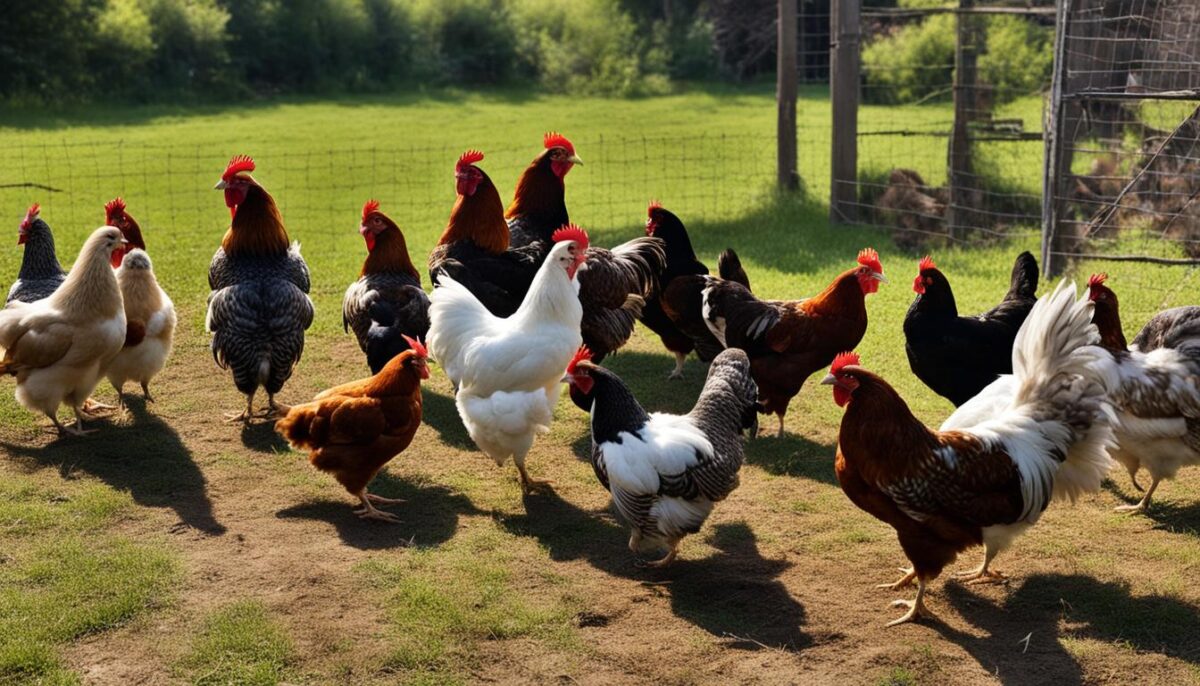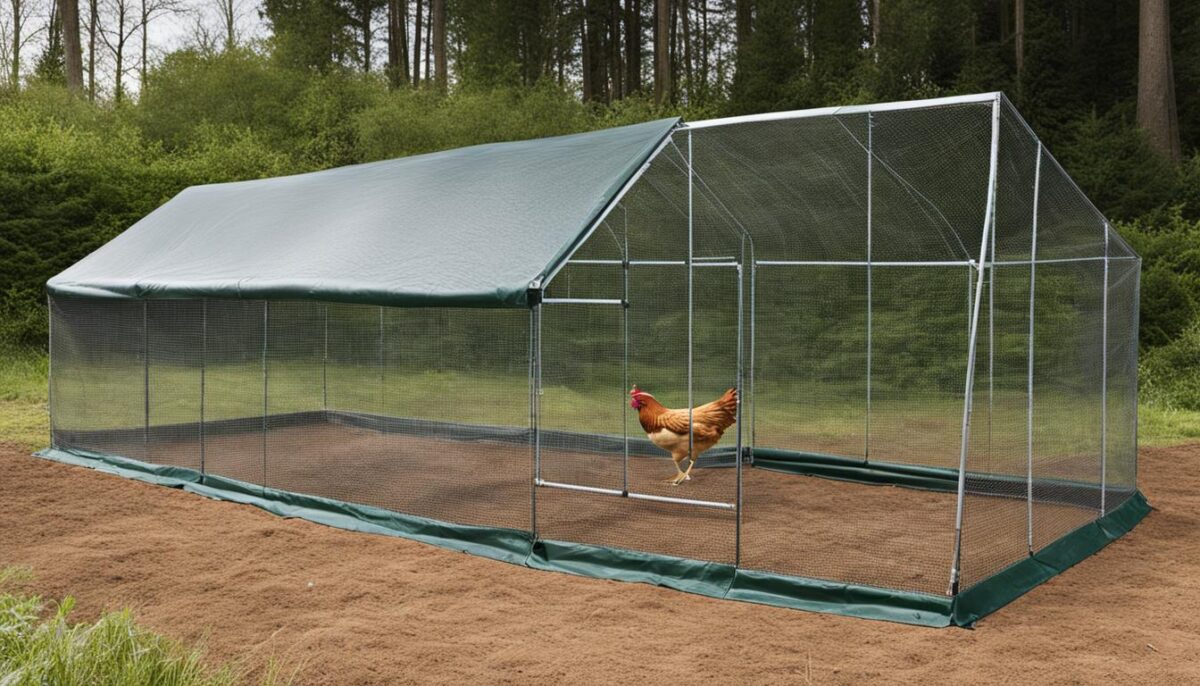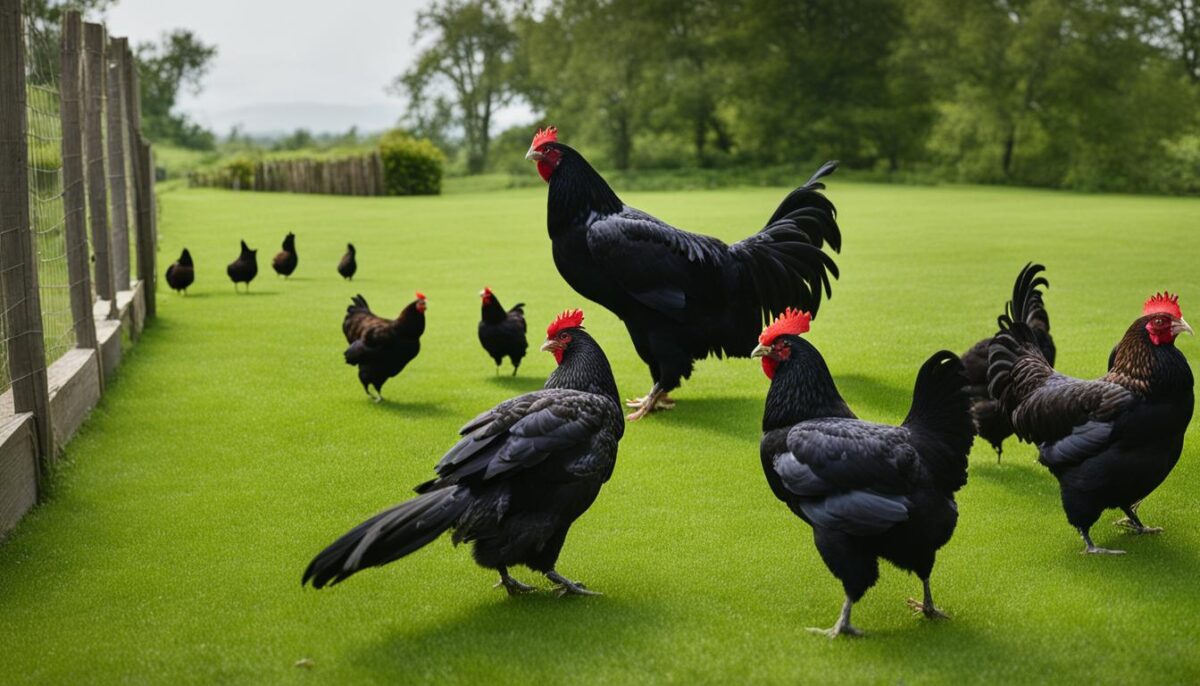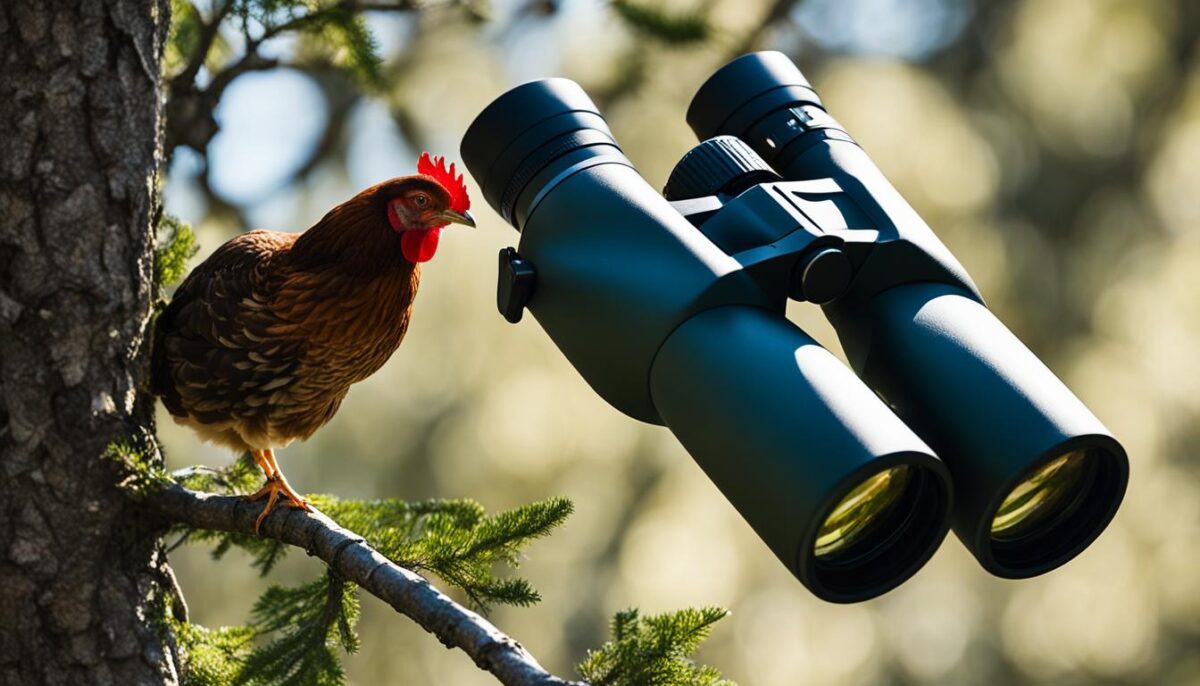Hawks can pose a significant threat to your poultry production efforts, preying on chicks and potentially spreading diseases. In this guide, we will provide several tips and tricks to help you protect your chickens from hawks and keep them safe and healthy.
Key Takeaways:
- Learn effective methods for chicken hawk control
- Discover natural chicken hawk deterrents
- Find out how to repel and deter chicken hawks
- Learn how to protect your chickens from hawks
- Discover humane ways to prevent and manage chicken hawks
Add A Rooster to Your Flock
Roosters have long been recognized for their protective instincts, making them an ideal addition to your flock if you’re looking to deter hawks and ensure the safety of your hens and chicks. With their keen eyesight and acute awareness of their surroundings, roosters can quickly detect the presence of predators, including hawks, and sound the alarm to alert the rest of the flock.
When a rooster spots a potential threat, it will raise the alarm by crowing loudly and flapping its wings, signaling the hens and chicks to seek cover. Roosters can also exhibit protective behavior by herding their flock to a safe area away from the threat, diminishing the risk of hawk attacks. These actions are instinctual for roosters and can be highly effective in deterring hawks.
Adding a strong and sturdy rooster to your flock can be an effective way to deter hawks.
It’s important to note that not all roosters exhibit the same level of protective instincts, so it’s wise to choose a breed known for its vigilance and courage. Breeds such as Rhode Island Reds, Plymouth Rocks, and Wyandottes are renowned for their protective nature and make excellent choices for safeguarding your flock against hawks.
In addition to their protective instincts, roosters can provide other benefits to your flock. They establish the social hierarchy within the group, ensuring harmony and order among the chickens. Roosters also play a crucial role in fertilizing eggs, allowing for natural reproduction within the flock.
When introducing a rooster to your flock, it’s important to consider the size and temperament of your existing chickens. Some hens may be intimidated or aggressive towards a new rooster, which can lead to conflicts within the flock. Proper acclimation and supervision are necessary during the integration process to ensure a smooth transition and the well-being of all the birds.
Summary
A rooster can serve as a natural deterrent to hawks, thanks to their protective instincts and ability to alert the flock to potential threats. By adding a strong and vigilant rooster to your flock, you can provide an extra layer of defense against hawk attacks and ensure the safety of your chickens. Just make sure to choose a breed known for its protective nature and properly introduce the new rooster to the existing flock for a harmonious integration.
Employ A Guard Animal
Guard animals can be a valuable asset in deterring chicken hawks and protecting your flock. Consider introducing dogs, alpacas, llamas, donkeys, guinea fowls, or geese to your chicken coop. These animals are known for their protective instincts and can alert you to the presence of a predator.
Dogs, for example, are loyal and excellent at detecting potential threats. Their presence alone can discourage hawks from approaching your chickens. Alpacas and llamas are also effective guard animals, as their large stature and protective nature can intimidate predators. Donkeys act as natural guards and will not hesitate to defend the flock. Guinea fowls and geese are territorial and make a lot of noise when danger is near, alerting the chickens and scaring away hawks.
It’s important to remember that training and proper management are crucial when employing guard animals. Introduce them to your flock gradually and ensure they are well-socialized. Monitor their interactions with the chickens to prevent any accidental harm. With the right training and care, guard animals can significantly reduce the risk of hawk attacks on your chickens.

Tips for Using Guard Animals:
- Choose the right guard animal based on their characteristics and compatibility with your flock.
- Train and socialize guard animals to ensure they are comfortable around chickens and know how to react to predator threats.
- Monitor the interactions between guard animals and chickens to prevent accidents or aggressive behavior.
- Consider adding multiple guard animals for better protection, especially if you have a large flock or a significant hawk presence in your area.
“Having a guard animal can provide an added layer of protection for your chickens. They can scare away hawks and alert you to potential threats, giving you peace of mind knowing your flock is safe.” – Poultry Farming Expert
| Guard Animal | Benefits |
|---|---|
| Dogs | Excellent detection skills and intimidation factor |
| Alpacas | Large stature and protective nature |
| Llamas | Effective at deterring predators |
| Donkeys | Natural guards with a strong defensive instinct |
| Guinea Fowls | Territorial and noisy, scaring away hawks |
| Geese | Alert and aggressive towards predators, providing early warning |
Coop Your Chickens
Cooping your chickens provides them with a safe and secure environment, protecting them from hawks. A chicken coop, also known as a chicken tractor or a chicken tunnel, can be constructed using chicken wire and PVC piping or boards. This portable coop allows your chickens to forage on fresh grounds while keeping them safe from predator attacks.
Not only does cooping your chickens provide protection, but it also offers added benefits for your garden. Chickens can help control weeds and insects that may harm your plants, improving the overall health of your garden.
Create a Chicken Tractor
A chicken tractor is a type of portable chicken coop that allows your chickens to graze on fresh grass while keeping them safe. To create a chicken tractor, you will need chicken wire, PVC piping or boards, and a sturdy frame. The chicken wire will form the walls and roof of the tractor, while the PVC piping or boards will provide support and structure.
| Materials | Instructions |
|---|---|
| Chicken wire | Measure and cut the chicken wire according to the desired size of the chicken tractor. |
| PVC piping or boards | Construct a frame using the PVC piping or boards to support the chicken wire walls and roof. |
| Sturdy frame | Ensure the frame is strong and stable to withstand external forces. |
Once the chicken tractor is built, you can easily move it around your property to provide fresh grazing areas for your chickens while keeping them protected from hawks.
Cooping your chickens is a practical and effective way to protect them from hawks. By providing them with a safe and secure environment, you can ensure the well-being of your flock while enjoying the benefits they bring to your garden.
Cover Your Chicken Run
Protecting your chickens from aerial attacks is crucial in ensuring their safety and well-being. One effective method to achieve this is by covering your chicken run. A chicken run cover acts as a barrier, making it difficult for hawks to swoop down and snatch baby chicks or young hens.
A chicken run cover also offers an additional layer of protection against falling debris. This reduces the chances of avian flu transmission through droppings of birds that fly over your chickens.
Installing a Chicken Run Cover
When it comes to installing a chicken run cover, there are a few options available:
- Netting: Use lightweight but sturdy netting with small holes to prevent hawks from accessing your chicken run. Ensure the netting is securely fixed to prevent any gaps.
- Wire mesh: Opt for wire mesh covers that are specifically designed to protect chickens from aerial predators. Make sure the mesh is tightly woven to prevent hawks from squeezing in.
- Tarpaulin: If you prefer a more solid cover, you can use a tarpaulin to create a roof for your chicken run. This will provide complete protection from aerial attacks.
Whichever option you choose, ensure that the cover is securely fastened and properly maintained to withstand the elements and the occasional hawk’s attempted entry.
| Pros | Cons |
|---|---|
| Prevents hawks from accessing chicken run | Requires regular maintenance |
| Provides additional protection against avian flu transmission | May restrict sunlight and ventilation |
| Easy to install | May incur additional costs |
Avian Flu Prevention
In addition to protecting your chickens from hawk attacks, a chicken run cover can also play a role in preventing the spread of avian flu. By preventing contact between wild birds and your flock, you reduce the risk of transmission through droppings.
Remember to regularly clean and disinfect your chicken run, as well as provide your chickens with a healthy diet and proper veterinary care to further minimize the chances of avian flu outbreaks.

By covering your chicken run, you can ensure the safety and well-being of your flock, protecting them from aerial attacks and reducing the risk of avian flu transmission. Choose the right cover option for your needs, maintain it properly, and provide your chickens with a healthy environment to thrive in.
Hawk Targeting Feeding and Watering Stations: Relocate for Enhanced Safety
When it comes to protecting your chickens from hawks, it’s important to consider all potential vulnerabilities. One area that hawks often target is feeding and watering stations, as chickens are most vulnerable when they lower their heads to eat or drink. By relocating these stations to a safer location, you can minimize the risk of hawk attacks and ensure the safety of your flock.
When hawks are spotted near your feeders or watering stations, it’s crucial to take immediate action. Remove or relocate the stations to an area where hawks are less likely to venture, such as closer to your coop or under some form of cover. This way, your chickens can still access food and water without exposing themselves to potential danger.
By relocating your feeders and watering stations, you create a safer environment for your chickens and decrease the likelihood of hawk attacks. This simple adjustment can significantly reduce the risk to your flock and provide you with peace of mind.
Table: The Benefits of Relocating Feeders and Watering Stations
| Benefits | Explanation |
|---|---|
| Reduced vulnerability to hawk attacks | Relocating stations to safer areas reduces the chances of hawks targeting vulnerable chickens. |
| Increased safety for chickens | By moving the stations, chickens can eat and drink without the constant fear of hawk attacks. |
| Peace of mind for the chicken owner | Knowing that your chickens are protected from hawks can provide a sense of security and reassurance. |
Relocating feeders and watering stations is a simple yet effective method to safeguard your chickens from hawks. Implementing this strategy, along with other protective measures, such as adding a rooster or employing guard animals, can significantly enhance the overall safety and well-being of your flock.
Adding Black Chicken to Your Flock
One effective method to deter hawks from targeting your chickens is by adding a black chicken to your flock. Hawks often mistake black chickens for crows, which they have a natural aversion to due to crows’ tendency to torment and chase hawks. By introducing a black chicken to your flock, you may keep hawks at a distance as they will avoid becoming a target of crow pestering.
There are several black chicken breeds that you can consider, such as Australorps, black Ameraucana, or black French Marans. These breeds not only add variety to your flock but also serve as a natural deterrent to hawks due to their coloration. The presence of a black chicken can create confusion for hawks, making them think twice before targeting your chickens.
It’s important to note that while adding a black chicken can help deter hawks, it should not be the sole method of protection. Implementing other strategies, such as having a rooster in your flock or employing guard animals, can further enhance your overall hawk deterrent efforts.

Table: Black Chicken Breeds
| Breed | Characteristics |
|---|---|
| Australorp | Dual-purpose breed, excellent egg layers, docile temperament |
| Black Ameraucana | Medium-sized breed, known for blue eggs, friendly and active |
| Black French Marans | Heavy breed, dark brown eggs, calm and friendly nature |
By diversifying your flock with a black chicken breed, you can add an extra layer of protection against hawk attacks. Remember to provide a safe and secure environment for your chickens, implementing multiple deterrent methods to ensure the well-being of your flock.
Increase Visibility
Increasing visibility in your surroundings is crucial when it comes to spotting hawks before they attack your chickens. One effective way to achieve this is by cutting down overgrown bushes and grasses that can provide cover for hawks to hide. By eliminating these hiding spots, you increase your chances of detecting the predator and taking measures to protect your flock.
However, it’s important to balance visibility with the need for chicken protection. While removing overgrown vegetation can help you spot hawks more easily, it can also leave your chickens exposed and vulnerable to other predators. Therefore, it’s essential to create a safe and secure environment for your chickens while ensuring good visibility to spot hawks.
To strike the right balance, consider creating designated areas with trimmed bushes or installing protective fencing around your chicken coop. This way, your chickens have a safe space to retreat to if they spot a hawk, while you still have clear visibility to monitor the surroundings for any potential threats.

Benefits of increasing visibility:
- Improved detection of hawks before they attack
- Ability to take timely action to protect your chickens
- Reduced risk of hawks hiding and stalking your flock
- Enhanced overall safety and security for your chickens
By increasing visibility and striking the right balance between chicken protection and hawk spotting, you can effectively safeguard your flock and minimize the risk of hawk attacks.
6 Ways to Scare Hawks Away
Protecting your chickens from hawk attacks is crucial for maintaining the safety and well-being of your flock. Luckily, there are several effective methods you can use to scare hawks away from your property. These tactics can help deter hawks and keep your chickens safe. Here are six ways to scare hawks away:
- Installing Guard Owls or Decoy Owls: Hawks are territorial creatures and often avoid areas where they believe other predators are present. By placing guard owls or decoy owls in your chicken coop or around your property, you can create the illusion of a threat, deterring hawks from approaching.
- Noise Deterrent Devices: Hawks are sensitive to loud sounds and can be startled by sudden noises. Utilizing noise deterrent devices, such as motion-activated alarms or wind chimes, can startle hawks and discourage them from targeting your chickens.
- Hanging Shiny Objects: Hawks are often deterred by shiny, reflective objects. Hanging aluminum plates, strips of foil, or CDs in your chicken coop or around your property can create a deterrent effect by reflecting sunlight and creating flashes of light that hawks find unsettling.
- Putting Up Scarecrows: Scarecrows can be an effective visual deterrent to hawks. Placing scarecrows in strategic locations around your chicken coop or garden can create the illusion of a human presence, making hawks think twice before approaching.
- Adding Wild Birdhouses: Attracting smaller birds to your property can help in scaring away hawks. Hawks are wary of areas where smaller birds are present, as these birds can alert your flock to danger. Installing wild birdhouses can encourage smaller birds to visit, creating a natural defense against hawks.
- Using Deer Netting or Fishing Line: Creating physical barriers using deer netting or fishing line can disrupt hawks’ flight paths and prevent them from swooping down to attack your chickens. These deterrents should be installed at varying heights across your property to create an obstacle that hawks will avoid.
By employing these scare tactics, you can significantly reduce the risk of hawk attacks on your chickens. It is important to remember that these methods should be used in combination with other protective measures to ensure the safety of your flock. Implementing a multi-layered approach to hawk deterrence will provide the best results and give your chickens the protection they need.

Conclusion
Protecting your chickens from predators, particularly hawks, is crucial to their well-being and your poultry production efforts. By implementing the effective strategies mentioned in this guide, you can keep hawks at bay and ensure the safety of your flock.
Adding a rooster to your flock can provide an extra layer of protection, as roosters have natural instincts to sound the alarm and protect the hens and chicks from potential threats. Employing guard animals, such as dogs, alpacas, llamas, donkeys, guinea fowls, or geese, can also help deter hawks and alert you to their presence.
Cooping your chickens and covering your chicken run are essential steps in creating a secure environment for your birds. These measures prevent hawks from swooping down and attacking vulnerable chickens. Relocating feeders and watering stations away from areas frequented by hawks can also reduce the risk of predation.
Additionally, consider adding a black chicken to your flock, as hawks often mistake them for crows, which hawks have an aversion to. Increasing visibility in your surroundings by trimming overgrown bushes and grasses helps you spot hawks before they strike. Finally, scare tactics like installing guard owls, using noise deterrent devices, hanging shiny objects, putting up scarecrows, adding wild birdhouses, or using deer netting or fishing line can further deter hawks from targeting your chickens.
FAQ
How can I protect my chickens from hawks?
There are several ways to protect your chickens from hawks. You can add a rooster to your flock, employ guard animals, coop your chickens, cover your chicken run, relocate your feeders and watering stations, add black chickens to your flock, increase visibility, and use scare tactics.
How can a rooster help protect my chickens from hawks?
Roosters have protective instincts and will sound the alarm and herd the chickens to safety when they spot a potential predator, such as a hawk.
What animals can I use as guard animals to protect my chickens from hawks?
Dogs, alpacas, llamas, donkeys, guinea fowls, and geese can be trained to sound an alarm when a predator, such as a hawk, is near and may even fight off attackers to keep your flock safe.
How can cooping my chickens protect them from hawks?
Cooping your chickens provides them with protection from hawks. Chicken tractors or chicken tunnels made from chicken wire and PVC piping or boards allow your chickens to forage on fresh grounds while keeping them safe from predator attacks.
Why is it important to cover my chicken run?
Covering your chicken run makes it difficult for hawks to swoop down and take a baby chick or young hen. These covers also serve as a barrier against falling debris, reducing the chances of avian flu transmission through droppings of birds that fly over your chickens.
Should I relocate my feeders and watering stations if I notice a hawk hanging around?
Yes, if you notice a hawk hanging around your feeders or watering stations, it’s important to remove or relocate them to a safer location until the hawk moves on. Hawks often target feeding and watering stations, as chickens are most vulnerable when they lower their heads to eat or drink.
How can adding a black chicken to my flock deter hawks?
Hawks often mistake black chickens for crows, which they have a natural aversion to due to crows’ tendency to torment and chase hawks. By adding a black chicken to your flock, you may keep hawks at a distance, as they will avoid becoming a target of crow pestering.
How can I increase visibility to spot hawks before they attack?
Increasing visibility in your surroundings by cutting down overgrown bushes and grasses eliminates potential cover for hawks to hide and increases your chances of detecting the predator. However, it’s essential to balance visibility with the need for chicken protection, as bushes can also provide a hiding spot for chickens when they spot a hawk.
What are some effective ways to scare hawks away?
There are several methods to scare hawks away, such as installing guard owls or decoy owls, using noise deterrent devices, hanging shiny objects like aluminum plates or strips of foil, putting up scarecrows, adding wild birdhouses to attract smaller birds that can alert your flock, and using deer netting or fishing line to create visual deterrents that hawks avoid.
How can I protect my chickens from hawks without harming the hawks?
It’s important to choose humane methods that do not harm the hawks, as they are protected by federal law. The strategies mentioned in this guide, such as adding a rooster, employing guard animals, cooping your chickens, covering your chicken run, relocating feeders and watering stations, adding black chickens to your flock, increasing visibility, and using scare tactics, are all humane ways to deter hawks and protect your chickens.


